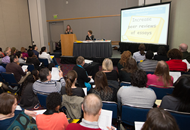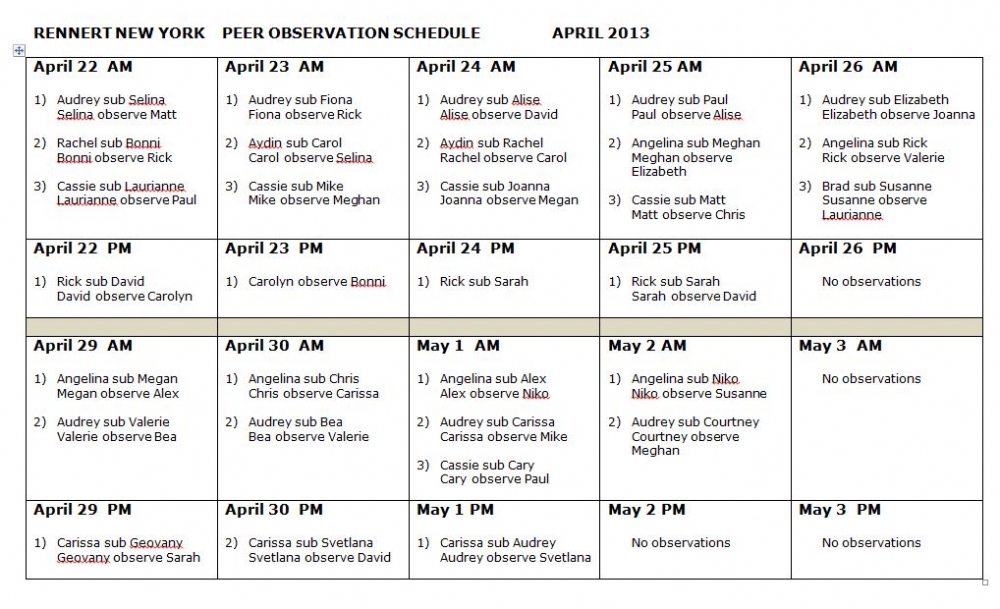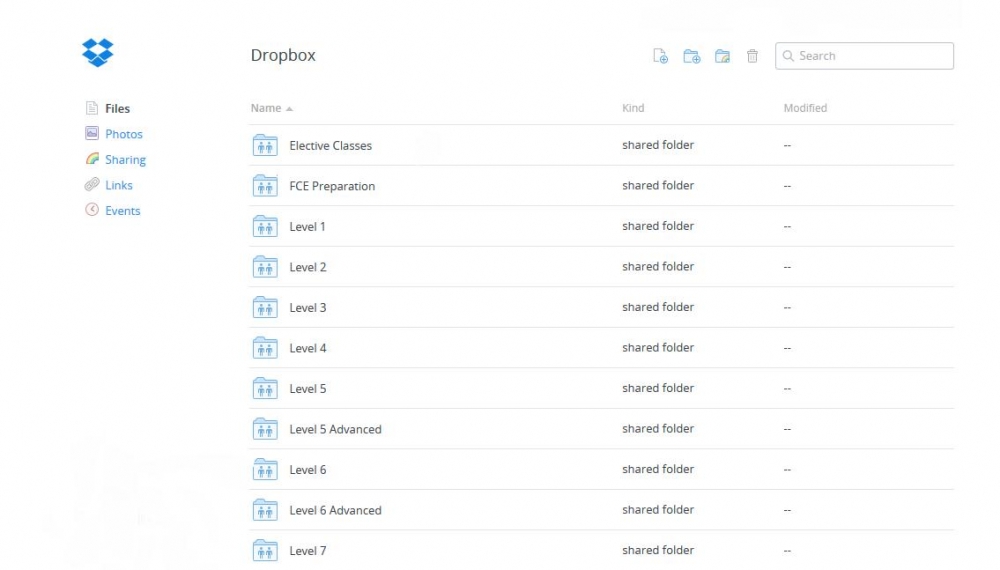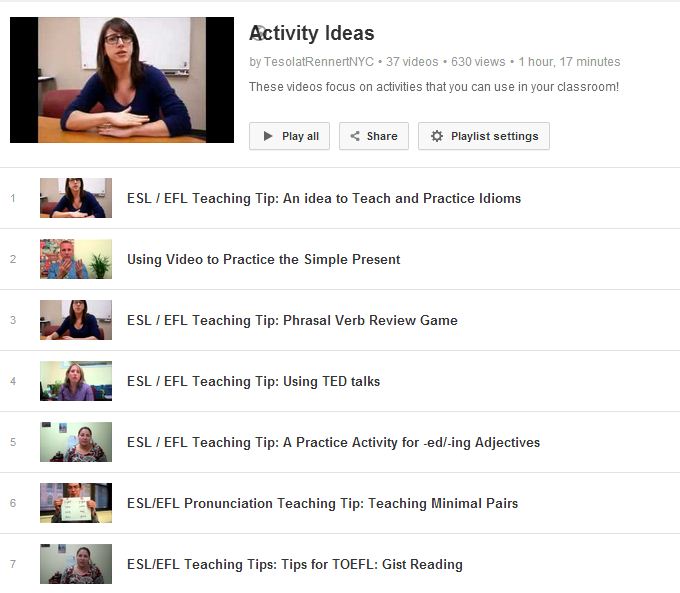5 Core Ideas to Build Effective PD Programs
by Autumn Westphal
 Providing meaningful and useful professional development (PD) can be a great way to keep your teachers motivated and using up-to-date practices. However, program administrators often find it difficult to ensure that these training opportunities are not only effective, but also that teachers feel motivated to participate in them. At TESOL 2014 in Portland, Oregon, my colleagues Noga La’or, James Stakenburg, and I presented five core ideas that we currently use to encourage and foster an environment of growth and teacher education at our school.
Providing meaningful and useful professional development (PD) can be a great way to keep your teachers motivated and using up-to-date practices. However, program administrators often find it difficult to ensure that these training opportunities are not only effective, but also that teachers feel motivated to participate in them. At TESOL 2014 in Portland, Oregon, my colleagues Noga La’or, James Stakenburg, and I presented five core ideas that we currently use to encourage and foster an environment of growth and teacher education at our school.
Types of PD
When creating a PD program at your school, it is helpful to offer a variety of types of PD in order to motivate teachers. To help create a program with variety, consider approaching PD from a few different angles: the administrator, the teacher, and the individual.
Administrator-Driven PD
This PD is managed by the administration at the school. The administrator would be at the core of whatever type of development was being offered—making PD information available, leading PD workshops (PDWs) or delegating the responsibility for PD to the appropriate person. For example, my school often subscribes to ELT publications that the teachers may not have access to. As we receive these publications, they are forwarded by the administrator to the teachers, or a printed version is placed in the teacher’s room.
Teacher-Driven PD
Teacher-driven PD is often initiated by the administrator, but then followed through with by the teacher. An administrator might create a PDW schedule, but the workshops themselves are led by the teachers at the school. Developing self-reflection by having teachers reflect (typically by filling out a form) before and after a teaching observation is another example of teacher-driven PD.
Individual-Driven PD
This type of PD is often the hardest to encourage or control on the part of the administrator. This type of PD is done at the discretion of the teacher and on his or her own time. Some examples include: reading books, subscribing to ELT magazines/publications/newsletters/websites/blogs, becoming a member of ELT organizations, attending webinars, attending conferences, and/or doing self-guided Internet research.
Keeping in mind who is driving the professional development is key when considering the five core ideas, as this ensures a variety of professional development options for teachers to take advantage of. The five core ideas are all administrator- and teacher-driven, with Core Idea #5 also being individual-driven.
The 5 Core Ideas
- Pre- and Post-Observation Meetings and Reflection
- Peer Observations
- Professional Development Meetings for Idea-Sharing
- Regularly Scheduled Professional Development Workshops
- Setting up an Online Presence for Professional Development
Core Idea 1: Pre- and Post-Observation Meetings & Reflection
It’s a common practice as a program administrator to observe teachers and provide them with feedback on their lessons. However, in order to fully maximize the potential of these observations, it can be helpful to follow these three steps:
a. PRE stage: Meet with the teacher to gather his or her thoughts on what he or she wants the observer to look for. In this meeting, the observer can also have the chance to inform the teacher about key issues that will be focused on during the observation. This can promote teacher buy-in and also empower the teacher to take charge of his or her growth and development. (See preobservation form example; PDF)
b. DURING stage: Observe the teacher, taking specific observation notes based on the discussion from the PRE stage. (See observation form example; PDF)
c. POST stage: Give the teacher a post-observation form to fill out before the post-observation feedback meeting to discuss the class observed. This helps focus the teacher before the feedback will happen. The form can also give the observer context for the feedback session—by knowing what the teacher noticed, the observer will be able to better guide the teacher to deeper reflection. (See post-observation form example; PDF)
Core Idea 2: Peer Observations
It can take a bit of finagling on the part of the program administrator, but creating a culture of peer observation in a school can greatly add to the spirit of collaboration among teachers. We advise that a school allows teachers to observe each other at any time, as long as it is first scheduled with their supervisor and the observing teacher can find coverage for his or her classes. Peer observations are important for all teachers, but especially for newer ones. By observing an experienced peer, a new teacher can get a better handle on the educational culture of the school in addition to gaining practical knowledge on how to handle his or her class.
Administrators can also ask teachers to observe as part of their PD. Again, peer observations are especially important for new or struggling teachers. By making peer observations a required part of a new teacher’s PD, you can guarantee that the teacher is getting the additional support he or she needs but may not ask for directly. One way to do this is to arrange a formal “peer observation” week (see Figure 1). Substitute teachers sub so teachers can observe. This means that the school needs to be willing to compensate teachers for the time they spend observing other teachers as well as finding or hiring substitutes as needed.

Figure 1. Peer Observation Week Example. (click here for enlargement; PDF)
Teachers must prepare and submit a lesson plan to the observing teacher. The observing teacher fills out a form (PDF), which is then shared with the program administrator and the observed teacher after the observation.
Core Idea 3: Professional Development Meetings for Idea-Sharing
Teachers often informally share ideas with each other over lunch or in the teachers’ room. In order to maximize this, though, it is important to give teachers the opportunity to formally share their teaching ideas with their peers. This can be done during regularly-scheduled teacher meetings, where every teacher is asked to come to the meeting with one activity idea to share with his or her fellow teachers. Meetings can also be specifically scheduled for idea-sharing.
One challenge that can arise from this core idea is that schools must be willing to compensate teachers for their time. However, you can schedule an idea share during an already-scheduled or required meeting, such as a yearly or monthly check-in, and then you are already compensating the teachers for this time. This can mean, however, that meetings could take a bit more time than originally planned. One more caveat is that one may find teachers can be territorial about sharing their tried-and-true activities with each other. One way to get around this issue is instead of sharing a game or activity, teachers could share a strategy for adapting or using the course book.
Core Idea 4: Regularly Scheduled PD Workshops
In our context, we host one to three 1-hour PDWs per month. This gives teachers a convenient and predictable source for PD. Teachers are asked to suggest topics and are polled for which topics would be of most use to them. Teachers are also invited to lead workshops on topics that interest them.
However, it can still be a struggle to build regular attendance. Consider compensating teachers for their time spent attending the PDWs and making attendance of a certain number of PDWs per year a requirement. This means that alternatives should be presented for those unable to attend the required number of PDWs. For example:
- Teachers may lead one PDW.
- Teachers may write a one-page summary of an academic article related to language teaching, which is then made available to the other teachers.
- Teachers may create a set of at least five classroom activities to be shared with other teachers.
- Teachers may attend a PDW at another location or attend a webinar (proof of attendance must be submitted).
- Teachers may record themselves teaching at least 1 hour of a lesson and write up a detailed summary/commentary/reflection of this lesson based on the video. This would then be submitted to a supervisor along with a formal lesson plan.
- Teachers may produce content (a blog post or a teaching tip video) for the school’s website or a social media platform managed by the school.
Core Idea 5: Setting Up an Online Presence for PD
This can be done privately (using a site that will only be shared among the teachers at the school, like Dropbox) or publically (using a site that can be accessed by anyone, like Facebook). This can encourage teachers to seek PD on their own time using social networking sites and websites that they are comfortable and familiar with. In order to encourage and maintain the production of content, an administrator (or even a teacher) should be in charge of managing the site(s) your school is active on. In our context, it is an administrator’s responsibility to curate, create, and post content. We make sure the teachers have access to the content and encourage (but don’t require) the teachers to participate in the creation of content.
Dropbox is a great resource for sharing ideas privately among the teachers at the school. Set up a folder for each level offered and allow teachers to upload/download resources to share with each other. (See Figure 2.)

Figure 2. Dropbox for PD (Click here for enlargement; PDF)
In our context, we manage a YouTube channel (TESOLatRennertNYC; see Figure 3), a Facebook page (TESOL Certificate Programs at Rennert NYC), a Wordpress blog (TESOL at Rennert NYC; see Figure 4), and a Twitter feed (@TESOLatRennert) that our teachers can access for class ideas. Teachers can also offer to write blog posts or create videos, but this is not required.

Figure 3. TESOL at Rennert NYC YouTube Channel.

Figure 4. TESOL at Rennert NYC Wordpress Blog.
To sum up, effective PD programs cater to the specific teaching context and needs of the teachers at the school. When thinking how to cater a program to the needs of the teachers, make sure to think about who drives the type of PD being offered. The greater variety that is offered, the more likely teachers will be to take part in the program. The core ideas in this article are a great jumping off point to maintaining a year-round PD program that leads to a school enviroment of community and collaboration.
Acknowledgment: The materials and ideas used for the basis of this article were produced in collaboration with James Stakenburg and Noga La’or.
________________________________
Autumn Westphal is the deputy head of teacher training at Rennert in New York City. She is a licensed teacher trainer and local trainer of trainers through the WL-SIT Graduate Institute. She works on developing curricula for teacher training courses and helps create PDWs for the teachers at her school.